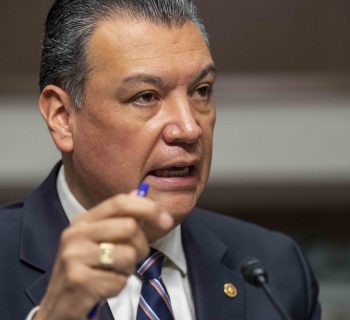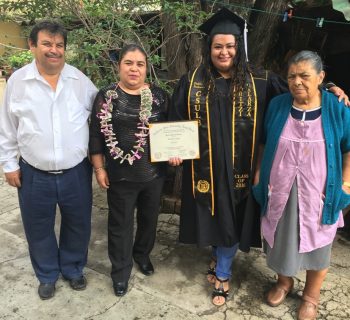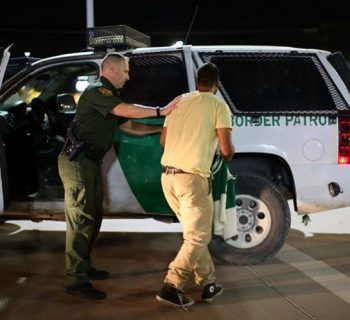By Dr. Frank Garcia Berumen
The recent protests related to the death of George Floyd have re-ignited the indignation of the long history of racism in the United States. The media coverage, policy commentaries, and demonstrations, have focused on the racism against African-Americans. However, racism is just not just an African-American experience and issue, but one experienced by every ethnic group. Long before the arrival of African-Americans, Europeans invaders had and have continued to vent, their most horrendous policies of racism and annihilation against Native Americans. However, the nation lives in a permanent state of historical amnesia in regards to the plight of indigenous peoples.
The oppression of Native Americans by Europeans began the first day that Christopher Columbus landed in the American continent on October 21, 1492, in the island of Guanahani (the Taino name), which today is part of the Bahamas. The native people who occupied this island were the Arawak, Taino, and Lucayan. Columbus and his men set about enslaving them, raping the women, stealing their valuables, and taking over the lands through murder, pillage, and plunder. Europeans also brought diseases such as smallpox, bubonic plague, chickenpox, cholera, etc. which killed millions. The brutal policy of the Spanish in the Caribbean resulted in the extinction of indigenous people in the area within twenty years.
Native scholars such as Roxanne Dunbar-Ortiz estimate that there were some 100 million indigenous peoples in the Americas when the European invaders arrived. Some 80% or 80 million lived in Mexico. Mexico was the “hearth of the continent,” from which commerce, ideas, and agriculture (such as corn, squash, and beans) where transmitted to the north and south. Highly developed native societies such as the Olmecas, Mayas, and Aztecas flourished in Mexico, as well as dozens of semi-nomadic tribes such as the Yaqui and Tahumara tribes.
The Spanish and other European powers considered themselves on a sacred mission given to them by the so-called Doctrine of Discovery. The doctrine was created by a papal decree of Pope Nicholas V in 1452, which sanctioned and promoted the conquest of non-Christian peoples throughout the world.
Thereafter, for the next five centuries Spain, England, France, Portugal, and other European nations duplicated these crimes, which constituted the greatest genocide in human history. The descendants of these conquistadores, pirates, and colonizers, continued the practice, when they inherited the stolen land and enslaved native peoples. They remained the economic and political power of the nation-states that developed in the late 1700s and early 1800s.
The Spanish instituted the encomienda system (a feudal peonage) throughout the present U.S. Southwest and through most of the Americas. The encomienda provided the Spanish with the land and the free labor of the indigenous populations and their fruits of their labor in mines, agriculture, road-building, construction, and the right to violate native women at will. They built Catholic missions, to both indoctrinate the native people with Christianity and to develop self-sustaining economic units. The average age of an indigenous person in a mission was five years. They were brutalized, tortured, and exploited to death.
Not to be outdone, the British and French arrived to pillage the eastern coast of North America in the 16th century. The first permanent English in Jamestown, in 1607 was the beginning of their ambitions to establish colonies and take the land. Although, most of the English brought families, they raped native women (regardless of the perpetuated mythology of the animated film Pocahontas), and began the practice of scalping. Some macho Europeans made a prosperous career by becoming “Indian fighters” and scalping native children, women, and men. Settler militias plundered and burned native agricultural fields, destroyed to the ground native villages and massacred at will. The term “redskin” was coined to describe the remains of native people skinned alive and left to rot in the fields.
The newly formed United States of America was founded on stolen Indian land natural resources; the annihilation of native peoples; and the growing plantation industry worked by enslaved Africans. After the war with Mexico in 1848, Mexican became a major labor force in agriculture and cattle-ranching. Soon thereafter, cheap European immigrant labor toiled in factories and mining. The new country quickly abolished the Proclamation of 1763, which the British had built as a barrier to European migration across the Appalachian Mountains. The ethos of Manifest Destiny, the concept that God had ordained Europeans to expand from sea to shining sea was the prime mover in the westward expansion. Of course, the desire was for “free land,” meaning stolen land from native people. During the mid-1800s, the United States federal government sent agents to Europe to recruit “cheap labor.” These poor white workers were promised not only well-paying jobs, but “free land!” And so they came by the millions (i.e. Irish, Scots, German, Polish, Italians, etc.). This became the often, misunderstood “American Dream.”
However, before this American Dream could become a reality, the land had to be cleared of its original inhabitants. Beginning in the late 1700s and continuing into the 1800s, the federal government and state governments began the so-called “Indian Wars” in every direction to eradicate and destroy native tribes. They took the form of massacres, forced removals, pitched battles, starvation, destroying their food sources (like the buffalo, sheep, agricultural fields, etc.), scalping, rape, the reservation system, diseases, and boarding schools, beginning in the 1630s (to which native children were forcefully taken to “kill the Indian” in them). Indigenous historian Roxanne Dunbar-Ortiz wrote in her book An Indigenous Peoples’ History of the United States, “Nearly all the population areas of the Americas were reduced by 90 percent following the onset of colonizing projects…from one hundred million to ten million.”
Treaties and laws were enacted to eradicate the Indian way of life.
Between 1781 and 1881, the U.S. Congress approved exactly 371 treaties with Native American nations, as required by the U.S. Constitution. However, there were many other treaties that were signed by the President of the United States, but not ratified by the U.S. Congress. As a result, there are some 600 treaties that indigenous tribes consider bona fide and legal. During this period of treaty making with the United States, some two million acres were taken from native tribes though coercion, fraud, and outright breach. At the end, not one single treaty was respected by the government.
The Dawes Act (or the General Allotment Act and/or the Dawes Severalty Act of 1887) was an effort to eradicate the tribal council and the land held in common by the entire tribe. It stipulated that each head of an indigenous household would receive 160 acres; and those under 18 years of age or orphans, 80 acres. The law was ripe with loopholes. Many whites adopted native children or orphans, and thereby appropriated the land. Surplus land was sold to non-natives. As a result, between 1887 and 1934, native tribes were dispossessed of some 100 million acres of land or two-thirds of what they held in 1887.
Between the mid-1940s and mid-1950s, the federal government began a new policy called the “Indian Termination Policy.” The policy has as its intention to end the federal government’s recognition of tribal sovereignty, the exclusion of state laws that was applicable to native peoples, and the termination of trustship over reservations. During 1953-1964, the federal government ceased the recognition of one hundred tribes and bands. As a consequence, more than 2,500,000 acres of trust land lost their protected status, and most of it was sold to non-native persons. The Termination Policy also included moving thousands of native people to urban centers with the promise of jobs and housing. The effort was a dismal and heart-breaking failure, as they found it impossible to find decent jobs and housing due to blatant racism and limited education.
Today, they are some 574 federally recognized tribes, nations, bands, rancherias, villages, and pueblos. Many tribes have never been recognized by the federal government and thereby are even more vulnerable to being appropriated by government and/or states. Native tribes continue to be “wards of the federal government,” who at their whim impose laws that limit their sovereignty, way of life, education, health, economic life, and their natural resources.
Indigenous People continue to be marginalized in several of ways
Native Americans are the most impoverished of all ethnic communities. One out of three Native Americans live in poverty; with a median income per year of $23,000 (American Community Survey, Northwestern Institute for Poverty Research, February 24, 2020). Only 50% of native students graduate from high school in the seven states with the largest indigenous population (The Civil Rights Project, 2010); and only 17% continue their education after high school compared with 60% of the U.S. population (Post Secondary National Policy Institute, 2019).
Indigenous people are imprisoned at 38% higher than the national average (Quartz, April 27, 2015). They are also, despite the ethnocentric media to the contrary, have the highest levels of killings with police encounters than any other ethnic group according to a Centers of Disease Control review for the years 1999 to 2013.The annual rate for Native Americans was 2.9%. This compares with African Americans with 2.6%; Latinos, 1.7%; Whites, 0.9%; and Asian or Pacific Islanders, 0.6% (CNN, November 13, 2017).
According to a study by Trauma, Violence & Abuse (June 16, 2016), Native Americans have the highest suicide rate than any other ethnic or racial group in the United States. Some 11.2% of all indigenous deaths are related to alcoholism (MSNBC, August 28, 2008).
Some have argued that one reason that the media and government often ignore Native Americans is that they constitute an insignificant percentage of the nation’s population. However, the demographic data is misleading. According to the 2010 U.S. Census, the total U.S. population totaled 308,745,538. The census results listed by race and/or ethnicity were as follows: White, 196,817,552 (63.7 %); Black or African American, 37,685,848 (12.2 %); American Indian and Alaska Native, 2,247,098 (0.7 %); Asian, 14,465,124 ((4.7 %); Native Hawaiian and other Pacific Islanders, 481,576 (0.15 %); two or more races, 5,966,481(1.9 %); some other race, 604,265 (0.2 %). Latinos remained the nation’s ethnic minority with 50,477,594 (16.3 %) of the total population.
The breakdown of the different Latino communities were as follows; Mexicans, 29.3 million; Puerto Ricans, 4.1 million; Cubans, 1.5 million; Salvadorians, 1.5 million; and Dominicans, 1.2 million. The total Central American population totaled 3.6 million; and those from South America, 2.5 million. The fact remains that Mexicans are indigenous people, as are most of the people from Central America. If the Mexican, Central American, and the “official Native American population” is added it totals 35,147,098 million! This is not an insignificant percentage of the nation’s population.
When the indigenous writer Sherman Alexie was asked to comment on Mexican immigration, he responded, “Let’s get one thing out of the way: Mexican immigration is an oxymoron. Mexicans are indigenous.”
The racial divide in the United States has only been framed as only Black and White in the media. Seldom does the media focus on native people in any way. The composition of national news staffs, movies, television, policy, and government concerns reflect this day after day, year after year. Native people are invisible, except for passing reference in school textbooks (most often distortions, such as in one high history book for example that lists the Massacre at Wounded Knee in 1890, as a battle!); and the proverbial stereotypes as sports mascots.
This writer surmises that the myopic media is due to several undeniable and irreversible, historical events and truths. Both indigenous peoples (and Mexicans) and African Americans have felt the hard sting of racism and marginalization for centuries. However, the experience of Native Americans is unique in U.S. History. For one, they are the original inhabitants of America (which is a continent and not one country). The twin evils of genocide and the robbery of the entire continent is irreversible. Euro-Americans will never tell indigenous people that they are going back to Europe or return the millions in the annihilated in the Native American genocide. In addition, indigenous people will continue to be considered “wards of the federal government.” The federal government continues to covet the natural resources and reservation lands. Indigenous people also have more than six-hundred treaties that were signed with the United States federal government. These treaties determine their marginalized realities.
African-Americans have had a different history of oppression and racism. For example, U.S. Senate Majority Leader Mitch McConnell (R), summarized the typical white perspective, “We’ve tried to deal with our original sin of slavery by fighting a civil war, by passing landmark legislation. We elected an African American President” (CNN, June 18, 2019). However, as we all know, laws may change, but the minds of people will not necessarily change. In the meantime, the scars of racism and marginalization live on forever.
However, what indigenous people/ Mexicans and African American can do together, is to build a coalition of support for each other. And to work together to eradicate the vestiges of the long-term racism that has oppressed both communities.
Dr. Berumen is an educator and writer. He has published several books on the Native American and Mexican American experience. His latest book is entitled American Image Makers of Hollywood (McFarland & Co., Inc.).
Copyrighted 2020 by Frank Garcia Berumen. All rights reserved. This article my not be duplicated or re-published without the expressed permission of the author.
Dr. Frank Garcia Berumen is a Harvard graduate with over 40 years of experience as a high school and college professor, a full-time writer and author of several books and articles related to Chicano and American Indian Studies.







